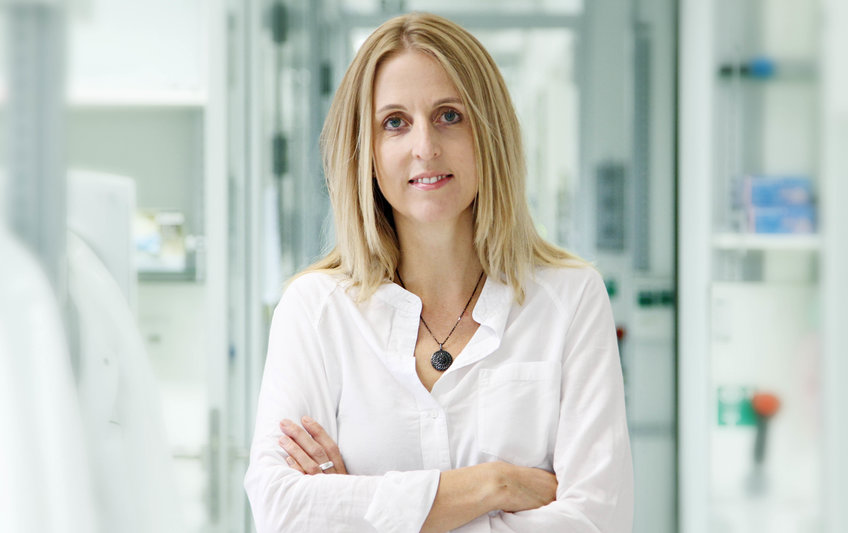
Rather B-cells than patents
Interview with MPIIB Alumna Hedda Wardemann
What mechanisms are at work here and how the immune system can protect us efficiently are questions that have captured the interest of Hedda Wardemann. The scientist researched autoimmune diseases – at one time as an assistant professor in New York – before becoming the head of a Young Investigator Group in 2006 at the Max Planck Institute for Infection Biology in Berlin. Since 2014, she has been investigating at the German Cancer Research Center (DKFZ), among other things, how the immune system mobilises to combat cancer cells in its own body. In an interview, she tells us about the challenges that her own research group is facing and how she very nearly became a patent attorney.
Dr. Wardemann, from 2006 to 2014, you researched at the Max Planck Institute for Infection Biology in Berlin. How did this period influence you?
In Berlin, I had an independent Max Planck research group. We were genuinely independent: we could make all decisions freely and we had no one dictating anything to us. That, of course, meant taking responsibility. So that is what I learned back then.
The infection research at the Max Planck Institute, especially, helped me grow as an immunologist: in Berlin, we worked on Malaria. The topic was already established there; we were well networked and so had access to samples. I still benefit from that to this day, because the question of what characterises protective immune responses is still one of the main lines of research in my current laboratory at the DKFZ. And we still collaborate closely with the Max Planck Institute for Infection Biology in Berlin on the topic of immune responses in malaria.
What was the greatest challenge in establishing your own research group in Berlin?
As a postdoc, or even as an assistant professor, one is integrated into a department. And the entire infrastructure is already there. In Berlin, I first had to build everything up; so I landed in the deep end as it were – partly, of course, because everything works differently in Germany from in the US. I didn’t know the system yet. It was all new to me and a completely different kind of challenge from what I knew from research.
When did you become certain that you wanted to be a scientist?
I think I realised that when I started as a postdoc in New York. At the time of finishing my doctorate in Freiburg, I wasn’t sure whether I wanted to stay in science. I toyed with the idea of maybe becoming a patent attorney. But then I ended up trying out a postdoc position abroad instead. And I enjoyed that enormously. It also helped that New York has a gigantic research environment. I think I knew then that I wanted to keep going.
And what made you come away from New York, to the Max Planck Institute for Infection Biology in Berlin?
I wanted to come back to Germany because of family. Since I had always been interested in infection research, the Max Planck Institute for Infection Biology seemed like the ideal place. I was an immunologist coming to this Institute that had so far researched primarily on pathogens. Establishing B-cell immunology as a new research field here was an exciting task.
Berlin was the right environment for it, too: the MPI is associated with the German Rheumatism Research Centre (DRFZ); the clinics of Charité are located directly on campus; the city is attractive for young people; and there is the international graduate school at the Max Planck. It was very easy to recruit young scientists here.
When you came to Berlin, you had a special method up your sleeve, which you had developed during your time in New York. What was that exactly?
It was a method for amplifying and sequencing antibody genes at the single cell level: from human blood or organs, we isolate B-cells, which produce antibodies. Each of these antibodies is coded by two genes, which we have to know to be able to produce them. Each cell uses different genes, and therefore has to be isolated and studied on its own.
In Berlin, we then received funding from the Max Planck Society and were able to convert the method into a high-throughput format: a robot platform that lets us look at the antibody gene information from many cells at a time. This platform supports us in pipetting and combines our gene amplification strategy with new sequencing methods. So, instead of maybe a hundred, we can now look at five thousand cells at a time and accordingly produce more antibodies. These can then be used as passive vaccines or as therapeutic antibodies – for example against malaria parasites or in cancer therapy.
The interview was conducted by Kai Dürfeld
Photo credit: Deutsches Krebsforschungszentrum (DKFZ)/Jutta Jung